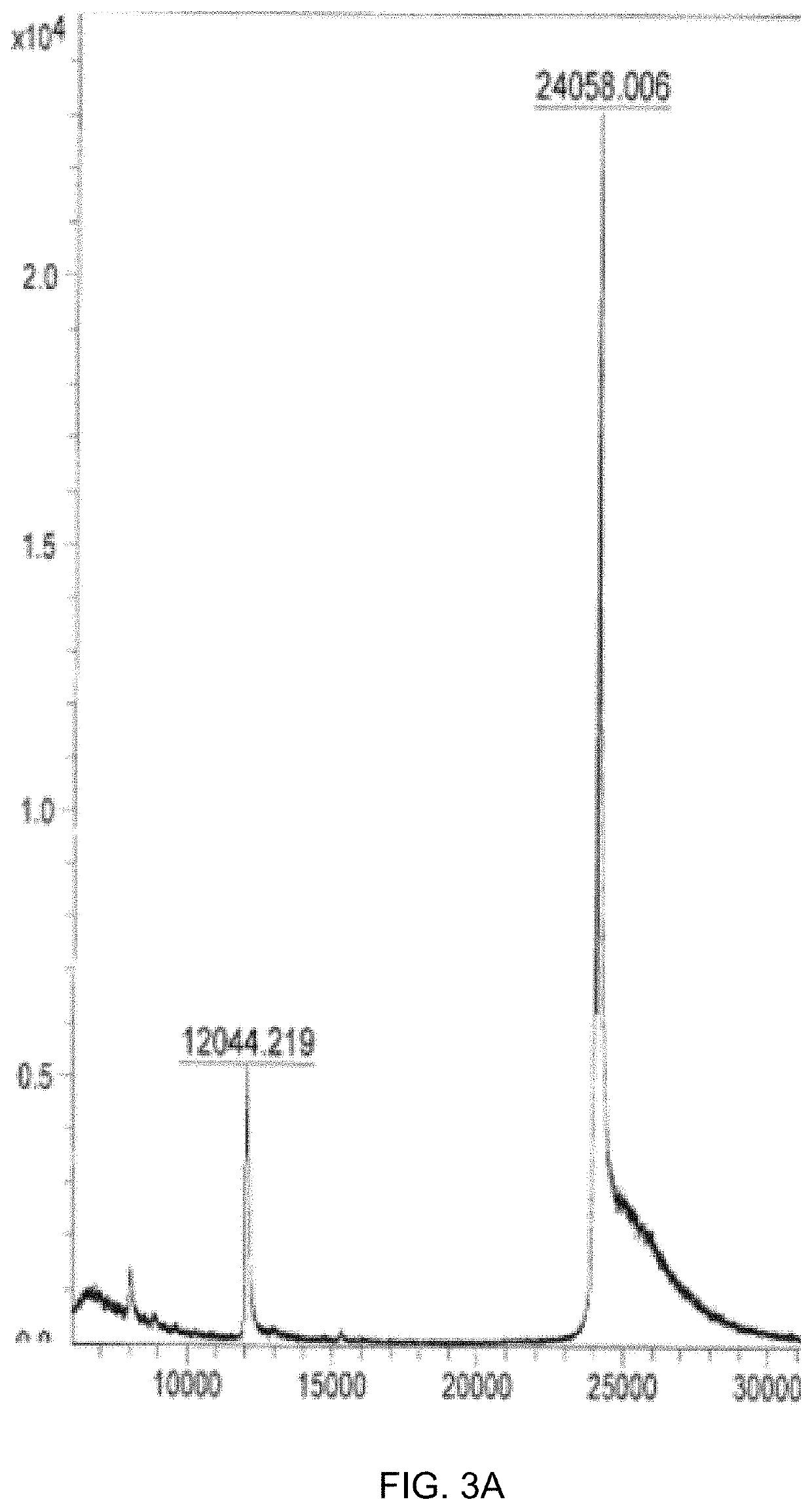Treatment of peanut allergy
a technology for treating peanut allergy and peanuts, applied in the direction of allergen ingredients, positive-sense ssrna viruses, biochemistry apparatus and processes, etc., can solve the problems of high public cost, time-consuming procedures, and risk of undesired allergic reactions, so as to improve the immune response, prevent and treat peanut allergy, and increase the effect of the generated immune respons
- Summary
- Abstract
- Description
- Claims
- Application Information
AI Technical Summary
Benefits of technology
Problems solved by technology
Method used
Image
Examples
example 1
Isolation and Cloning of a Coat Protein (CP) of Cucumber Mosaic Virus (CMV)
[0126]Total RNA from CMV-infected lily leaves was isolated using TRI reagent (Sigma, Saint Louis, USA) in accordance with manufacturer's instructions. For cDNA synthesis, a OneStep RT-PCR kit (Qiagen, Venlo, Netherlands) was used. For amplification of the CMV CP gene, primer sequences were chosen following analysis of CMV sequences from GenBank: CMcpF (CACCATGGACAAATCTGAATCAACCAGTGCTGGT) (SEQ ID NO:8) and CMcpR (CAAAGCTTATCAAACTGGGAGCACCCCAGATGTGGGA) (SEQ ID NO:9); NcoI and HindIII sites are underlined. The corresponding PCR products were cloned into the pTZ57R / T vector (Fermentas, Vilnius, Lithuania). E. coli XL1-Blue cells were used as a host for cloning and plasmid amplification. To avoid selecting clones containing PCR errors, several CP gene-containing pTZ57 plasmid clones were sequenced using a BigDye cycle sequencing kit and an ABI Prism 3100 Genetic analyzer (Applied Biosystems, Carlsbad, USA). After ...
example 2
Expression of CP of SEQ ID NO:1 in E. coli Leading to VLPs of CMV
[0127]To obtain CMV VLPs, E. coli C2566 cells (New England Biolabs, Ipswich, USA) were transformed with the CMV CP gene-containing plasmid pET-CMVwt. After selection of clones with the highest expression levels of target protein, E. coli cultures were grown in 2×TY medium containing kanamycin (25 mg / 1) on a rotary shaker (200 rev / min; Infors, Bottmingen, Switzerland) at 30° C. to an OD600 of 0.8-1.0. Then, the cells were induced with 0.2 mM IPTG, and the medium was supplemented with 5 mM MgCl2. Incubation was continued on the rotary shaker at 20° C. for 18 h. The resulting biomass was collected by low-speed centrifugation and was frozen at −20° C. After thawing on ice, the cells were suspended in the buffer containing 50 mM sodium citrate, 5 mM sodium borate, 5 mM EDTA, 5 mM mercaptoethanol (pH 9.0, buffer A) and were disrupted by ultrasonic treatment. Insoluble proteins and cell debris were removed by centrifugation (...
example 3
[0129]Cloning of a Modified Coat Protein of CMV Containing a Tetanus Toxoid Epitope (CMV-Ntt830)
[0130]To replace the original amino acids at the N-terminus of CMV CP of SEQ ID NO:1 with the tetanus toxoid epitope coding sequence, the pET-CMVwt plasmid was used for PCR amplification and mutagenesis. A SalI site located within the CMVwt gene (FIG. 1) was used for cloning the corresponding PCR products.
[0131]To introduce the tetanus toxoid epitope coding sequence into the CMVwt gene, a two step PCR mutagenesis was used. For the first step amplification, the following primers were used: pET-220 (AGCACCGCCGCCGCAAGGAA (SEQ ID NO:11)-upstream from polylinker, the amplified region includes BglII site) and CMV-tt83-1R (ATTTGGAGTTGGCCTTAATATACTGGCCCATGGTATATCTCCTTCTTAAAGT) (SEQ ID NO:12). For the second round, the PCR product from the first amplification was diluted 1:50 and re-amplified with primers pET-220 (SEQ ID NO: 11) and CMV-tt83Sa1-R2 (GACGTCGACGCTCGGTAATCCCGATAAATTTGGAGTTGGCCTTAATATA...
PUM
| Property | Measurement | Unit |
|---|---|---|
| Mw | aaaaa | aaaaa |
| pH | aaaaa | aaaaa |
| temperature | aaaaa | aaaaa |
Abstract
Description
Claims
Application Information
 Login to View More
Login to View More - R&D
- Intellectual Property
- Life Sciences
- Materials
- Tech Scout
- Unparalleled Data Quality
- Higher Quality Content
- 60% Fewer Hallucinations
Browse by: Latest US Patents, China's latest patents, Technical Efficacy Thesaurus, Application Domain, Technology Topic, Popular Technical Reports.
© 2025 PatSnap. All rights reserved.Legal|Privacy policy|Modern Slavery Act Transparency Statement|Sitemap|About US| Contact US: help@patsnap.com



